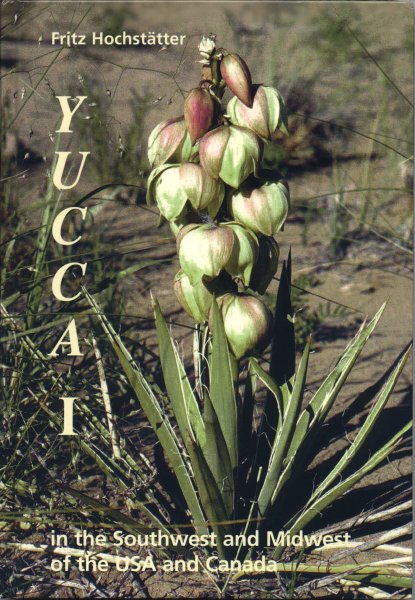Hard cover, glossy paper, 256 pages, 174 colour photos, more than 50 drawings (flowers, leaves, roots, capsules, seeds), 10 distribution maps
Published April 2000, Fritz Hochstätter
with Seed Morphology by Dr.Günter Hentzschel
English Translation by Chris Holland
German Summaries
![]()
| The genus Yucca has been for many years one of the worst documented groups of succulent plants. The work of previous monographers Trelease (1902) and McKelvey (1938 and 1947) are almost unobtainable and many of the original descriptions are buried in obscure botanical publications. It was probably for this reason that the genus Yucca was not included in Jacobsen's Succulent Lexicon as the work contains far less succulent species of other genera. This is a pity because Yuccas have great utility as garden ornamentals, yet only a relatively few species are widely grown. It is therefore of great value to have a new extensive work on the genus which brings together a wealth of past information as well as extensive photographic documentation of plants in habitat. I have seen many Yuccas in habitat in the USA and Mexico over the years and have more often than not been totally unable to identify the species. Having studied this book and its companion volume I feel I do now have a better understanding of the group. Keys, drawings of seeds, capsules and leaves (both in profile and cross section) should all help in the process of identification. Distribution maps will also be valuable to field identification. Volume I of the work covers the dry, capsular, dehiscent-fruited species which are included in the sections Hesperoyucca Engelmann and Chaenocarpa Engelmann of which Hochstätter recognises 15 species and 18 subspecies, including two new combinations. The photographs are of a uniformly high standard and well printed on high quality art paper throughout. The book is bound in strong laminated board covers which will be useful if it is used in habitat trips. In addition to wild plants there is a section on plants in cultivation in gardens in the USA and Europe, frequently including pictures of their owners which to me certainly adds to the interest of the book. The book includes photo images or transcriptions of the first descriptions of the Yucca species which it covers, which in view of the inaccesibility of many of them is very useful. The book is available from Navajo Country in Europe for € 79.-- plus € 3.20/pp (abroad € 5.80). Unfortunately not cheap but this sort of price arises from small printing run books, with large numbers of colour illustrations. See also the reviews of Yucca II and Yucca III. A website has been started which will provide on-line some of the information from this series of books.
Contents:
|  |
|---|
![]()

